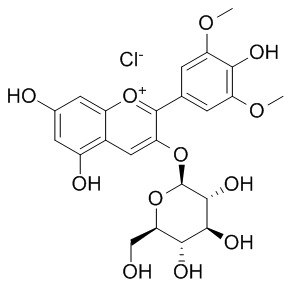Malvidin-3-O-glucoside chloride
Malvidin 3-glucoside has antioxidant activity, alone is not oxidized in the presence of grape polyphenol oxidase. Malvidin 3-glucoside's color stabilization at a higher pH can be explained by self-aggregation of the flavylium cation and copigmentation with the Z-chalcone form.
Inquire / Order:
manager@chemfaces.com
Technical Inquiries:
service@chemfaces.com
Tel:
+86-27-84237783
Fax:
+86-27-84254680
Address:
1 Building, No. 83, CheCheng Rd., Wuhan Economic and Technological Development Zone, Wuhan, Hubei 430056, PRC
Providing storage is as stated on the product vial and the vial is kept tightly sealed, the product can be stored for up to
24 months(2-8C).
Wherever possible, you should prepare and use solutions on the same day. However, if you need to make up stock solutions in advance, we recommend that you store the solution as aliquots in tightly sealed vials at -20C. Generally, these will be useable for up to two weeks. Before use, and prior to opening the vial we recommend that you allow your product to equilibrate to room temperature for at least 1 hour.
Need more advice on solubility, usage and handling? Please email to: service@chemfaces.com
The packaging of the product may have turned upside down during transportation, resulting in the natural compounds adhering to the neck or cap of the vial. take the vial out of its packaging and gently shake to let the compounds fall to the bottom of the vial. for liquid products, centrifuge at 200-500 RPM to gather the liquid at the bottom of the vial. try to avoid loss or contamination during handling.
Front Chem.2023, 11:1245071.
J Liq Chromatogr R T2025, 2505536.
Nutrients.2017, 10(1)
Nutr Res Pract.2020, 14(5):478-489.
Regen Biomater.2023, 10:rbad077.
J Control Release.2024, 375:300-315.
Cell Mol Biol (Noisy-le-grand).2023, 69(15):167-173.
Int J Mol Sci.202, 25(17):9246.
Food Bioscience2023, 52:102412
Metabolites. 2023, 13(11):1122.
Related and Featured Products
J Food Biochem. 2008 Sep 23;32(5):576-596.
Anthocyanin Interactions with DNA: Intercalation, Topoisomerase I Inhibition and Oxidative Reactions.[Pubmed:
19924259]
Anthocyanins and their aglycone anthocyanidins are pigmented flavonoids found in significant amounts in many commonly consumed foods. They exhibit a complex chemistry in aqueous solution, which makes it difficult to study their chemistry under physiological conditions.
METHODS AND RESULTS:
Here we used a gel electrophoresis assay employing supercoiled DNA plasmid to examine the ability of these compounds (1) to intercalate DNA, (2) to inhibit human topoisomerase I through both inhibition of plasmid relaxation activity (catalytic inhibition) and stabilization of the cleavable DNA-topoisomerase complex (poisoning), and (3) to inhibit or enhance oxidative single-strand DNA nicking. We found no evidence of DNA intercalation by anthocyan(id)ins in the physiological pH range for any of the compounds used in this study-cyanidin chloride, cyanidin 3-O-glucoside, cyanidin 3,5-O-diglucoside, Malvidin-3-O-glucoside chloride and luteolinidin chloride. The anthocyanins inhibited topoisomerase relaxation activity only at high concentrations (> 50 muM) and we could find no evidence of topoisomerase I cleavable complex stabilization by these compounds.
CONCLUSIONS:
However, we observed that all of the anthocyan(id)ins used in this study were capable of inducing significant oxidative DNA strand cleavage (nicking) in the presence of 1 mM DTT (dithiothreitol), while the free radical scavenger, DMSO, at concentrations typically used in similar studies, completely inhibited DNA nicking.
Finally, we propose a mechanism to explain the anthocyan(id)in induced oxidative DNA cleavage observed under our experimental conditions.
Nat Commun . 2018 Feb 2;9(1):477.
Epigenetic modulation of inflammation and synaptic plasticity promotes resilience against stress in mice[Pubmed:
29396460]
Abstract
Major depressive disorder is associated with abnormalities in the brain and the immune system. Chronic stress in animals showed that epigenetic and inflammatory mechanisms play important roles in mediating resilience and susceptibility to depression. Here, through a high-throughput screening, we identify two phytochemicals, dihydrocaffeic acid (DHCA) and malvidin-3'-O-glucoside (Mal-gluc) that are effective in promoting resilience against stress by modulating brain synaptic plasticity and peripheral inflammation. DHCA/Mal-gluc also significantly reduces depression-like phenotypes in a mouse model of increased systemic inflammation induced by transplantation of hematopoietic progenitor cells from stress-susceptible mice. DHCA reduces pro-inflammatory interleukin 6 (IL-6) generations by inhibiting DNA methylation at the CpG-rich IL-6 sequences introns 1 and 3, while Mal-gluc modulates synaptic plasticity by increasing histone acetylation of the regulatory sequences of the Rac1 gene. Peripheral inflammation and synaptic maladaptation are in line with newly hypothesized clinical intervention targets for depression that are not addressed by currently available antidepressants.



